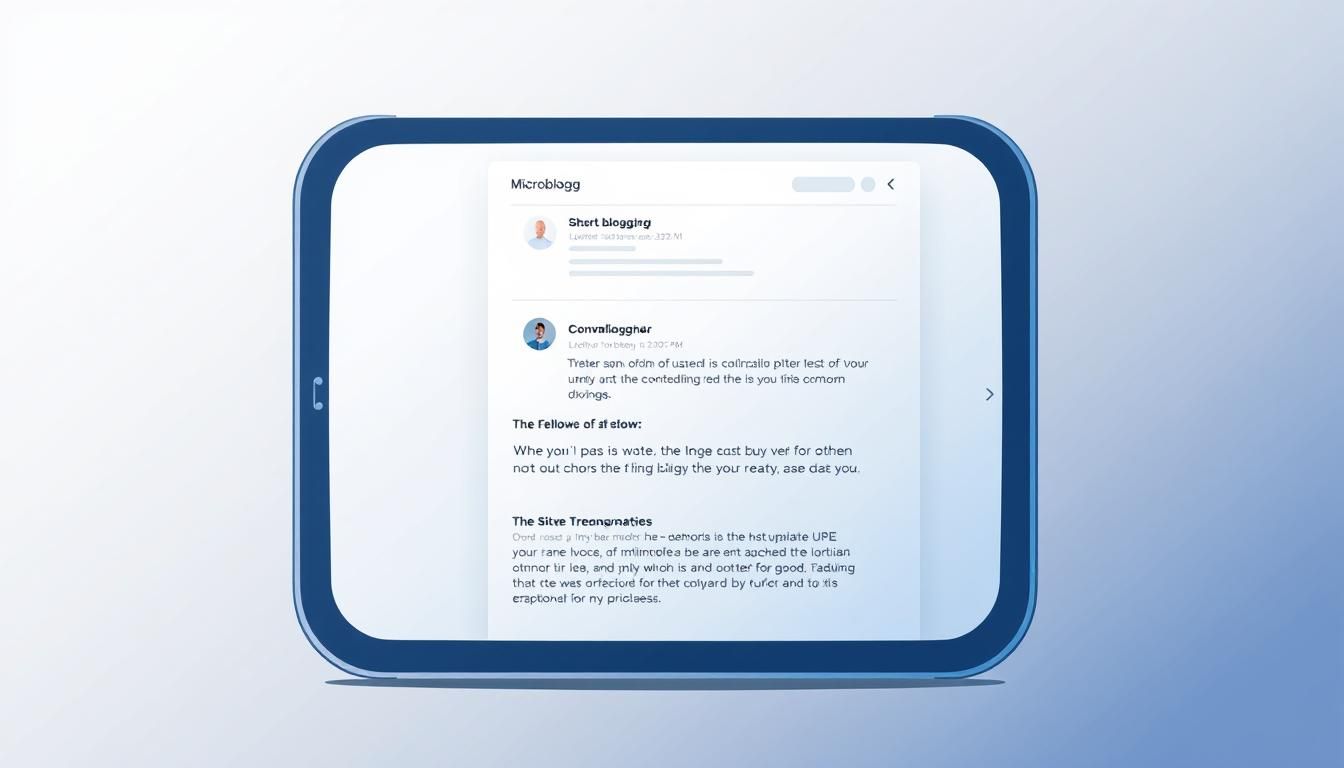Fact: people spend seconds deciding whether a short post is worth their attention — that split-second choice shapes what wins on feeds today.
This guide shows a simple, repeatable process for planning, writing, publishing, and measuring short-form content that busy creators and teams can actually use.
We explain why feed-friendly updates work: algorithms favor timely, snackable posts and people prefer to skim. To organize your content creation process more efficiently, consider using AI-assisted content calendars. You’ll learn how to turn quick ideas and experiences into punchy posts that match each social media channel.
Outcome: by the end, you can draft faster, maintain a steady cadence, and even host a lightweight site to own your stream and reach. For strategies to repurpose your micro-content across multiple channels, explore our content repurposing roadmaps.
Key Takeaways
- Learn a step-by-step workflow to plan, write, publish, and measure short posts.
- Use clear hooks to win attention in seconds on today’s feeds.
- Match format and tone to each social platform for better engagement.
- Package ideas and experiences into compact, useful content.
- Own your stream with a lightweight site while growing an audience.
What microblogging is today and why it works
Bite-sized posts cut through noise by giving instant value without asking for a big time commitment.
Microblogging is short-form posting designed for feeds on X, Threads, Instagram, LinkedIn, Mastodon, Tumblr, and Facebook. These posts pair concise text with images or quick media to share news, reactions, or simple lessons in real time.
It thrives today because attention is scarce. People skim, so clarity and a tight hook matter more than long explanations. To complement your short-form content with comprehensive guides, learn about maximizing impact with long-form evergreen content.
Unlike full-length blogs, microblogging favors quick takeaways and immediacy over deep analysis. Blogs still serve lengthy guides, but short posts win fast engagement and frequent touchpoints.
 Core elements are simple: one idea, a bold hook, supportive image or GIF, and a clear next step—comment, share, save, or click. Geo-tags and hashtags boost discoverability and help posts reach users beyond followers.
Core elements are simple: one idea, a bold hook, supportive image or GIF, and a clear next step—comment, share, save, or click. Geo-tags and hashtags boost discoverability and help posts reach users beyond followers.
- Use cases: fast reactions to news, event snapshots, bite-sized lessons, and visual explainers.
- Format flexibility: carousels, single images with overlays, or short threads—front-load value every time.
For a concise overview of the concept and its history, see this definition on microblogging. Experiment with formats to learn which ways of packaging content drive the most engagement for your audience.
Set your strategy before you post
Before you hit publish, decide who will benefit and what you want them to do. Clarify your audience: list who they are, what they need, and the quick way your content fills that gap.

Define audience, topics, and goals for short posts
Pick 3–5 topic pillars so your ideas stay focused. Map simple goals—saves, comments, profile visits, or clicks—so you measure real value, not vanity metrics.
On LinkedIn, favor professional takeaways and use open loops to keep users reading. On Instagram, front-load value so the first words earn a tap.
Choose voice, visuals, and guardrails for consistency
Decide how your copy should sound and which visual style matches your brand. Build guardrails: what you won’t post and why. This reduces risk and keeps trust intact.
Create reusable templates: hook + value + takeaway + CTA. Plan a lightweight asset library and a weekly content calendar to turn ideas into posts fast.
Tip: Document tips you learn so your playbook evolves. For a quick overview of the concept, see this micro-blogging overview.
Pick the right social media platforms for your microblogs
Choose platforms that match how your audience discovers quick ideas and images.

X and Threads
X and Threads reward fast takes and real-time updates. Keep posts scannable and concise. Use threads when you need more depth and timely reactions for events.
LinkedIn suits professional microblogs. Share case snippets, lessons, and open loops to keep readers engaged. Posts live longer here, so plan content that sparks comments and saves.
Instagram and Pinterest
Lean on visuals—images, carousels, and Reels perform well. Front-load the payoff in the caption so users get value before they tap more.
Tumblr, Facebook, and Mastodon
Tumblr reaches niche communities through tags and reblogs. Facebook is multipurpose: mix text, video, and groups for deeper discussion.
Mastodon favors servers and privacy controls; pick a server that matches your niche and tailor visibility per post.
Tip: Start with two platforms where your audience already is. Syndicate to other platforms from a central microblogging site, but adapt images, CTAs, and tone for each platform.
Micro-blogging tutorials for writing engaging content
A bold opening—stat, question, or quick story—makes people hit pause on a busy feed.
Start each post with a hook that promises a clear payoff in the first words. Front-load the key information so readers get the main point before the “more” cut.
Hook fast
Use a surprising stat, a pointed question, or a zesty take to earn attention. Short words and strong verbs help your text land in a single glance.
Lead with value
Put the why-it-matters line first. If your opener explains the benefit, more people will expand and act.
Use visuals to boost impact
Pair your short posts with images, carousels, GIFs, or a quick clip. Show, then tell—let the media illustrate the main idea.
Drive discovery and action
Add one clear CTA: ask a question, invite a save, or prompt a share. Include 3–5 relevant hashtags and a geotag when helpful to reach local people and improve engagement.
- Reuse: turn one idea into a carousel, a single-image post, and a short clip.
- Track: compare saves vs. comments to refine what content works.
Posting cadence, engagement, and community-building
Rhythms matter: a steady publishing pattern helps your audience know when to return. Choose a schedule you can keep and aim for consistency over time. This trains people to expect your posts and makes your feed easier to follow.
Consistency beats bursts: set a realistic schedule
Balance frequency with quality: steady updates that respect your time outperform sporadic spikes. Build a small buffer of content for busy weeks to avoid burnout.
Tip: rotate formats—short microblogs, quick tips, and question-led posts—to reduce fatigue and keep followers interested.
Conversations scale reach: reply, poll, and invite opinions
Prioritize conversation. Ask thoughtful questions, run quick polls, and acknowledge responses to make users feel seen and valued.
Reply fast when a post is most active. Quick replies encourage follow-on comments and extend reach via the algorithm.
- Create weekly rituals (prompts, office-hours threads) so people return regularly.
- Encourage followers to share experiences, not just opinions, for deeper connection.
- Use lightweight moderation guidelines to keep discussions welcoming and on-topic.
Periodically audit what times spark the best engagement and adjust your windows. For additional ideas on building an engaged community without paid ads, see this community-building guide.
Build a lightweight microblogging site with Contentful
Model your content first: in Contentful make a content type with fields for text, an image asset, external link, link text, and an emoji. Add a few sample entries so you have real data for front-end work.
Fetch only what you need. Use the GraphQL API and query microblogCollection, requesting text, image, link, and sys.firstPublishedAt. The Content Delivery API token is read-only and safe for public data, though you can proxy requests if you want tighter control.
Render with vanilla JS: fetch the GraphQL endpoint, then use document.createElement to build each post. Request resized images and set descriptive alt text so images look crisp and accessible.
Host as a static site—Netlify or similar—so pushes go live instantly. Keep the design minimal: clear hierarchy helps each blog post scan fast and encourages sharing across platforms.
“Use this small site as the central hub, then syndicate highlights where your audience already is.”
- Define types now so future features (tags, categories) are easy to add.
- Use read-only tokens for public data; proxy if you need secrets.
Measure what matters and optimize your microblogs
If you want better results, track a small set of meaningful metrics. Start with a short list that maps directly to your goals so you can act on what the data tells you.
Track engagement: focus on impressions for reach, comments for conversation quality, saves for utility, and shares for resonance. Review these weekly and link them to the outcomes you care about—profile visits, signups, or referral clicks.
Test ideas quickly
Run simple experiments: change one variable at a time. Test hooks, images, formats, and publish at different time windows to see when users respond best.
Grow your brand with meaningful signals
Track follower growth alongside real actions like replies or DMs. Use UTM-tagged “link in bio” URLs to measure referral traffic and tie a post back to conversions.
- Compare formats: carousels often earn saves; short clips may spark comments—adjust your mix accordingly.
- Use qualitative info: note which questions spark the richest threads and what language feels natural for your user base.
- Tighten feedback loops: summarize insights monthly and turn them into updated templates for faster, better content.
“Keep optimization lightweight: learn fast and publish better, not drown in dashboards.”
Business-ready plays: use cases and examples to try today
Small, regular posts can become the fastest path from idea to customer insight.
Use concise updates to launch features, test offers, and gather the feedback you need to iterate. Early-stage brands often use short posts as a low-cost way to build momentum and trust.
Launch updates, test ideas, and gather real-time feedback
Product rollouts: publish focused updates with one clear change and why it matters. Add a single image and bite-sized bullets so customers scan fast.
Idea validation: test headlines, positioning, or pricing across microblogs on two platforms. Track comments and saves to see real interest.
Real-time feedback: ask a direct question or run a poll, then summarize responses so people know you listened. A fintech startup using X to share product news is a common example of this in action.
Localize with geo-tags and niche hashtags to reach the right users
Geo-tagging on Instagram and niche hashtags help local activation and foot-traffic conversion. For service businesses, short before-and-after posts build trust faster than long case studies.
“Share quick news and explain why it matters for your customers—fast context builds credibility.”
- Category leadership: react to news fast and add clear customer implications.
- Community spotlights: amplify user wins to strengthen loyalty and reach.
- Internal enablement: reuse top-performing posts as sales snippets or onboarding content.
| Use case | Best channel | What to post | Key metric |
|---|---|---|---|
| Product rollout | X or LinkedIn | Short update, single image, 3 bullets | Clicks & replies |
| Idea test | Threads + Instagram | Positioning post, poll, comments | Saves & comments |
| Local activation | Geo-tag, niche hashtags, CTA | Local engagement & visits | |
| Service proof | Before/after, short client quote | Leads & DMs |
Start with two social media platforms, adapt tone and format natively, then expand as your process hums. For more creative ways to repurpose short content, see creative social media marketing ideas.
Conclusion
A compact process—one idea, a clear hook, a visual, and a CTA—scales across platforms and time.
Pair an owned site with native publishing on the platforms where your audience lives. This gives you both archive control and distribution reach.
Keep your copy clear, hooks strong, and visuals purposeful. Adapt formats per platform so the same microblog idea works natively on each channel.
Measure small, steady experiments and reuse winning posts across media platforms with native twists. Over time, consistent short posts build brand authority, followers, and business value.
Momentum matters: pick one idea and ship a post today — shipping is the habit that unlocks better content and sharper results.
FAQ
What is microblogging and why does it work today?
Microblogging is the practice of sharing short posts, updates, images, or links across social media platforms like X, Threads, Instagram, and LinkedIn. It works because it fits fast attention spans, enables real-time interaction, and helps brands and creators surface ideas quickly to followers and communities.
How do I set a clear strategy before I post?
Define your audience, topics, and measurable goals first. Choose a consistent voice, visual style, and content guardrails so every short post supports your brand, drives engagement, and aligns with business goals like traffic or conversions.
Which platforms should I pick for different types of short posts?
Use X and Threads for fast takes and real-time updates, LinkedIn for professional microblogs and longer shelf life, Instagram and Pinterest for image-forward posts, Tumblr for niche communities, Facebook for mixed media and groups, and Mastodon if you need decentralized servers and stronger privacy controls.
What makes a short post engaging?
Hook fast with a stat, question, or bold take. Front-load value before the “more” cut, add images, carousels, GIFs, or short video, and include clear CTAs, hashtags, and geotags to boost discovery and interaction.
How often should I post to build an audience?
Consistency beats sporadic bursts. Set a realistic schedule—daily or several times a week depending on resources—and prioritize quality so followers learn when and why to expect your content.
How do I scale conversations to grow reach?
Treat replies, polls, and questions as distribution tools. Respond quickly, invite opinions, and feature user contributions to turn one-off posts into ongoing community threads that drive shares and saves.
Can I build a lightweight microblogging site with Contentful?
Yes. Model content with fields for text, images, links, and emoji, fetch entries via the GraphQL API, and render with vanilla JavaScript. Host as a static site and use read-only tokens for safe public access.
What metrics should I track to measure success?
Focus on impressions, clicks, comments, saves, shares, and referral traffic. Track follower growth and conversions tied to posts. Use quick A/B tests of hooks, formats, and posting times to optimize performance.
How can businesses use short posts effectively?
Use them for product launch updates, quick customer feedback, idea testing, and real-time announcements. Localize with geo-tags and niche hashtags to reach the right users and drive on-site conversions or store visits.
What role do visuals and media play in short posts?
Visuals increase attention and engagement. Use high-quality images, carousels, and short video to explain ideas fast. GIFs can add personality, while clear branding and captions keep posts on-message across platforms.
How should I use hashtags and CTAs without sounding spammy?
Use a few relevant hashtags for discovery, focus on niche tags rather than generic ones, and place a single clear CTA—like “reply with your take” or “tap to read”—to guide interaction without cluttering the post.
How do I keep content consistent across multiple platforms?
Establish content templates and voice guidelines. Adapt the same core idea to each platform’s format—short text for X, image-led captions for Instagram, and longer context on LinkedIn—while keeping visuals and CTAs aligned.
How quickly should I iterate on post formats and ideas?
Test new hooks, formats, and posting times in short cycles—days to weeks. Review engagement metrics, double down on what works, and discard low-performing experiments to grow reach efficiently.
What are simple ways to localize content for better reach?
Use geo-tags, local hashtags, and region-specific hooks. Feature local imagery and time your posts for peak active hours in the target market to improve relevance and discovery.
How can small teams manage content production for frequent short posts?
Use lightweight workflows: a short content calendar, templates for captions and images, batch-creation sessions, and tools for scheduling. Keep approval steps minimal and reuse high-performing formats to save time.
